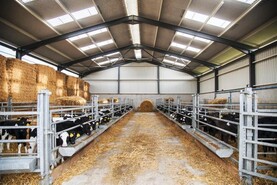The level of investment in farm infrastructure has increased significantly in recent months. This is stemming from the sector working to get back on track following a significant coronavirus-related slowdown in construction in the first half of 2020.
As reported in recent weeks, this trend is evident globally and is being fast-tracked in many countries by huge financial stimulus packages aimed at kick-starting economic growth.
The downside to this growth is the extra pressure on creaking raw material supply chains, also hammered by coronavirus, and the resultant increase in costs that has occurred. Steel and timber are the worst affected, with costs rising by 20% to 25%. Long lead-in times from ordering to receiving materials have also developed.
Increased costs
This surge in raw material costs is significantly increasing the costs of investing in farm infrastructure and, in many cases, is stretching finances apportioned to projects to the limit.
The best hope of working through the increased costs is to keep a good handle on quotes, particularly where they are live and open to change, and to explore how increased costs will be financed, ideally before works have commenced.
Despite the increased costs, there has been no significant slowdown in building activity.
Bank of Ireland agricultural development manager in Leinster Susan Maher says the rate at which funds are being drawn down for farm development works for the first half of 2021 is running at about twice the level of the corresponding period in 2020.
Higher confidence
Susan says improved farmgate prices are generating higher levels of confidence and encouraging many farmers to push ahead with projects despite the increased costs, while a significant number of farm building developments are non-discretionary and are required to stay compliant with nitrates regulations or provide housing for expansion which has already taken place.
“We are typically seeing two scenarios – farmers who have tied into a contract and are largely insulated from further price increases and those who received quotes some time ago and are now going back to suppliers or manufacturers and finding the quote has increased anywhere from 15% to 30%.
“The latter are the group that are facing the greatest challenge,” adds Susan.
Project review
Susan says that the best option to overcome these challenges is to review the project budget and where funds are being borrowed, to speak with the relevant financial institution as soon as possible about revising budgets.
“More options can generally be explored the earlier the project is reviewed.
“For large-scale projects, we recommend a contingency of 10-15%, this will help offset some of the increase.
When a farm takes on more debt than it can afford, it can lead to future growth being stifled and hinder performance of the business for many years
“A key aspect is to get an accurate handle on the level of overspend likely first, as this information is vital in being able to access your options and will be required to secure additional bank funding. Ignoring the problem, hoping you can cover it from farm cash-flow or using creditors, will only result in bigger problems down the road.”
Increasing the level of borrowings is an option and may be the best solution, assuming the business can afford it. Where there is an insufficient repayment capacity, more debt is not the solution. When a farm takes on more debt than it can afford, it can lead to future growth being stifled and hinder performance of the business for many years and be the source of untold financial and personal stress.
Loan restructuring
“The answer for some may be more debt and/or restructuring of existing debt. A review of this option will look at potential future output in addition to future expenses, which may be unforeseen in the current arrangement, such as children going to college, for example.
“For others, it may be reviewing the extent of the project and examining if costs can be stripped back. This does not mean sacrificing the quality of the build, as this brings its own risks.
“Rather it is about looking at the extent of the project and asking if there are components which can be finished at a later stage, such as an extra concrete apron for example, or downsizing the build, but leaving it in such a manner that it can be added to easily in the future.”
[...] it is also important to assess what implications significant changes to the farm’s sales pattern may bring for tax liabilities
Selling non-priority stock or liquidating non-essential items items (off-farm assets not core to the farming business) may also be sufficient in raising the funds – tweaking the production system to free up capital is another option.
“In any of these scenarios, it is also important to assess what implications significant changes to the farm’s sales pattern may bring for tax liabilities, as resolving one issue now can create another down the line without proper planning.”
Another option which needs to be considered is whether the best solution is to delay the project. Factors that will come into play here are the timeline for planning permission and possible grant aid, while environmental compliance, labour efficiency and improving the work-life balance is becoming increasingly important for progressing with a development.
In short
Planning early and reviewing the project with an accurate assessment of costs is central to finding a positive resolution. At the end of the day, the development has to work for everyone, deliver the required efficiencies and be affordable.






 This is a subscriber-only article
This is a subscriber-only article










SHARING OPTIONS: